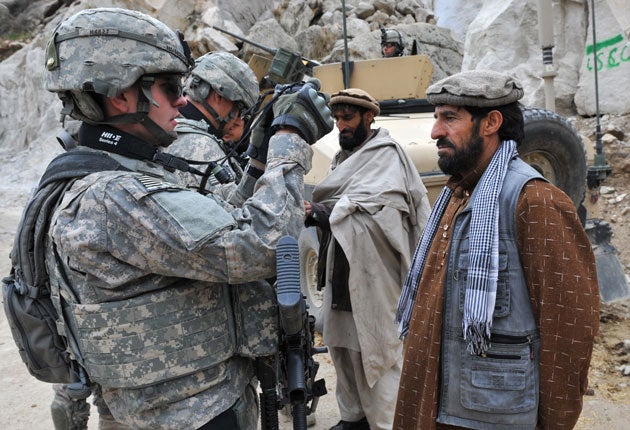US reservists reveal truth about the battle for Nuristan

Your support helps us to tell the story
From reproductive rights to climate change to Big Tech, The Independent is on the ground when the story is developing. Whether it's investigating the financials of Elon Musk's pro-Trump PAC or producing our latest documentary, 'The A Word', which shines a light on the American women fighting for reproductive rights, we know how important it is to parse out the facts from the messaging.
At such a critical moment in US history, we need reporters on the ground. Your donation allows us to keep sending journalists to speak to both sides of the story.
The Independent is trusted by Americans across the entire political spectrum. And unlike many other quality news outlets, we choose not to lock Americans out of our reporting and analysis with paywalls. We believe quality journalism should be available to everyone, paid for by those who can afford it.
Your support makes all the difference.Nato spoke of "some fighting" at the end of May in Nuristan province.
Parliament members and local media claimed dozens of deaths in an indiscriminate air strike.
Now, the US soldiers who fought in this remote corner of north-eastern Afghanistan appear to have cut through the spin, telling their local newspaper of a ferocious battle after Taliban fighters seized a tiny mountain village and raised the flag of the Islamist movement.
US reservists from the Iowa National Guard told the Globe Gazette that the fight to recapture Du Ab district centre was the "most significant" firefight their unit had been in since World War II.
"It's unbelievable everyone came out," said Lt Col Steven Kremer of the National Guard's 1st Battalion, 133rd Infantry Regiment.
Nato pulled most of its forces back from the rugged province two years ago to concentrate on protecting more densely populated areas in the valleys below.
The Taliban arrived in its wake. Government presence is minimal. The insurgents are blockading the provincial capital, and Afghan MPs and opposition politicians allege the government wants to keep Nuristan out of the spotlight.
According to the reservists' account, 42 US soldiers and 18 Afghan troops were scrambled by helicopter after reports on 25 May that the Taliban had raised their flag over the district centre. They came under fire within seconds.
"The whole [landing zone] erupted into fire," 1st Lt. Justin Foote said. "From every point of high ground, from every piece of defensible fighting position the enemy were in, it pretty much rained down – all types of weapons: small arms fire, machine gun fire, RPG fire and enemy mortar rounds."
The fighting was so severe that it took two detachments dropped within 300 metres of each other an hour to link up. Resupply helicopters with reinforcements and ammunition were subjected to such withering fire that they spent barely a minute on the ground and one was too badly damaged to unload its cargo.
Their dramatic account, however, contradicts Nato's initial statement. "Afghan and coalition forces air assaulted into Du Ab district, Nuristan province today to assess insurgent activity," its press release on the day read.
Although there had been "some fighting" there was "no indication at this time the district was ever overrun".
Nato also said, on first appraisal, "there was no damage to property and no civilians injured".
Contingent events in Du Ab made the spin on what happened particularly troubling.
Amid the chaos, ground forces called in airstrikes, one of which struck a group of police, killing them. Several civilians were also killed in the fighting.
But when The Independent made inquiries immediately after the airstrikes, sources said that medical teams were being denied access to the province by the Afghan government. Another source said civilians trying to flee the fighting in Du Ab were being sent back by Afghan security forces.
A Nato spokesman said the alliance stood by its initial release.
"The [Nato] release acknowledged there was fighting at the helicopter landing area," Colonel Hans Bush said.
"The incident assessment team that landed within 48 hours of the engagement went through the district centre itself (a short distance north of the helicopter landing area) and found no indication of fighting in the district centre... [It] was abandoned and Taliban may well have walked in and walked out but there did not appear to be any fight [there]."
Join our commenting forum
Join thought-provoking conversations, follow other Independent readers and see their replies
Comments